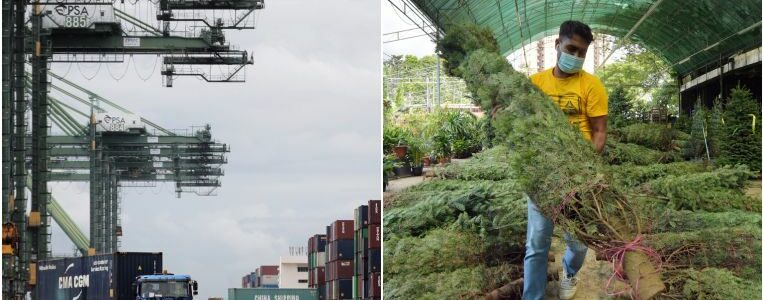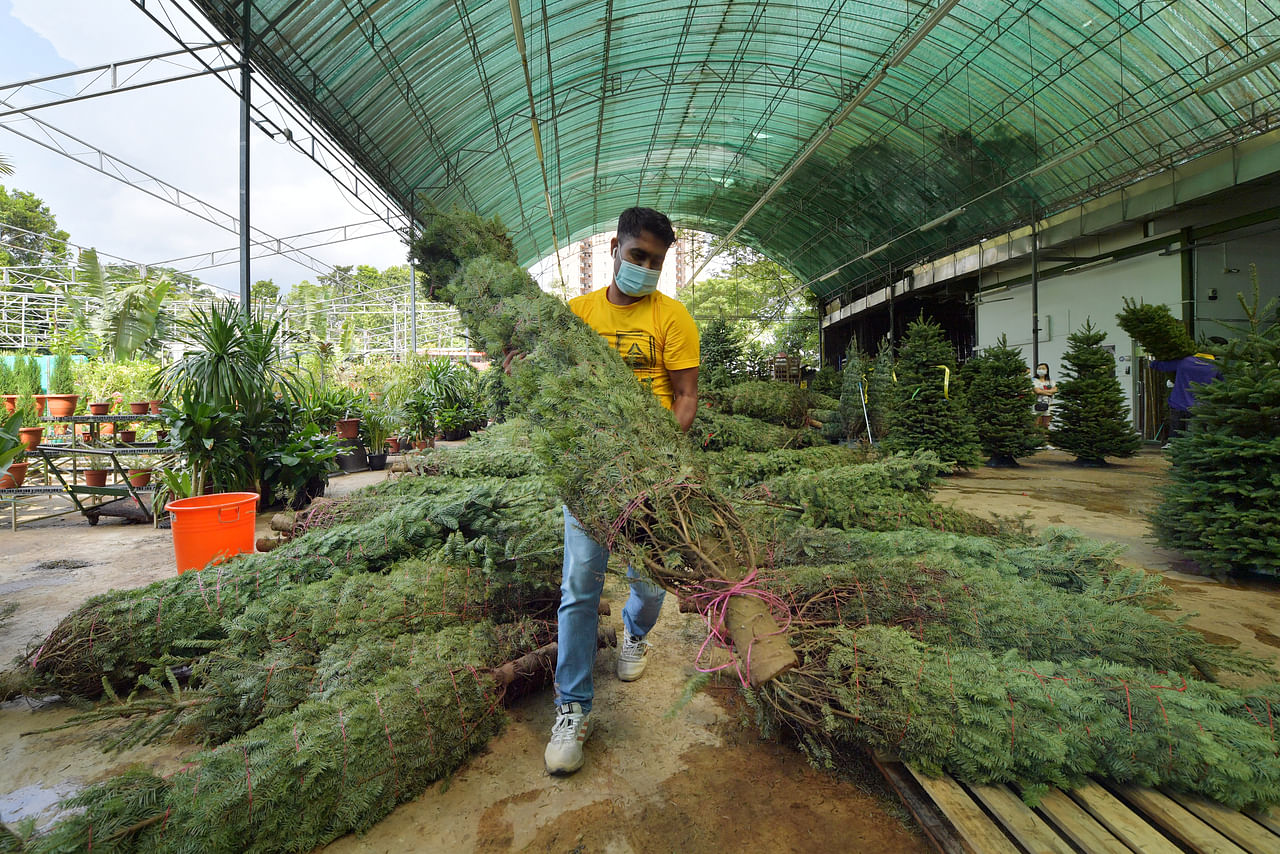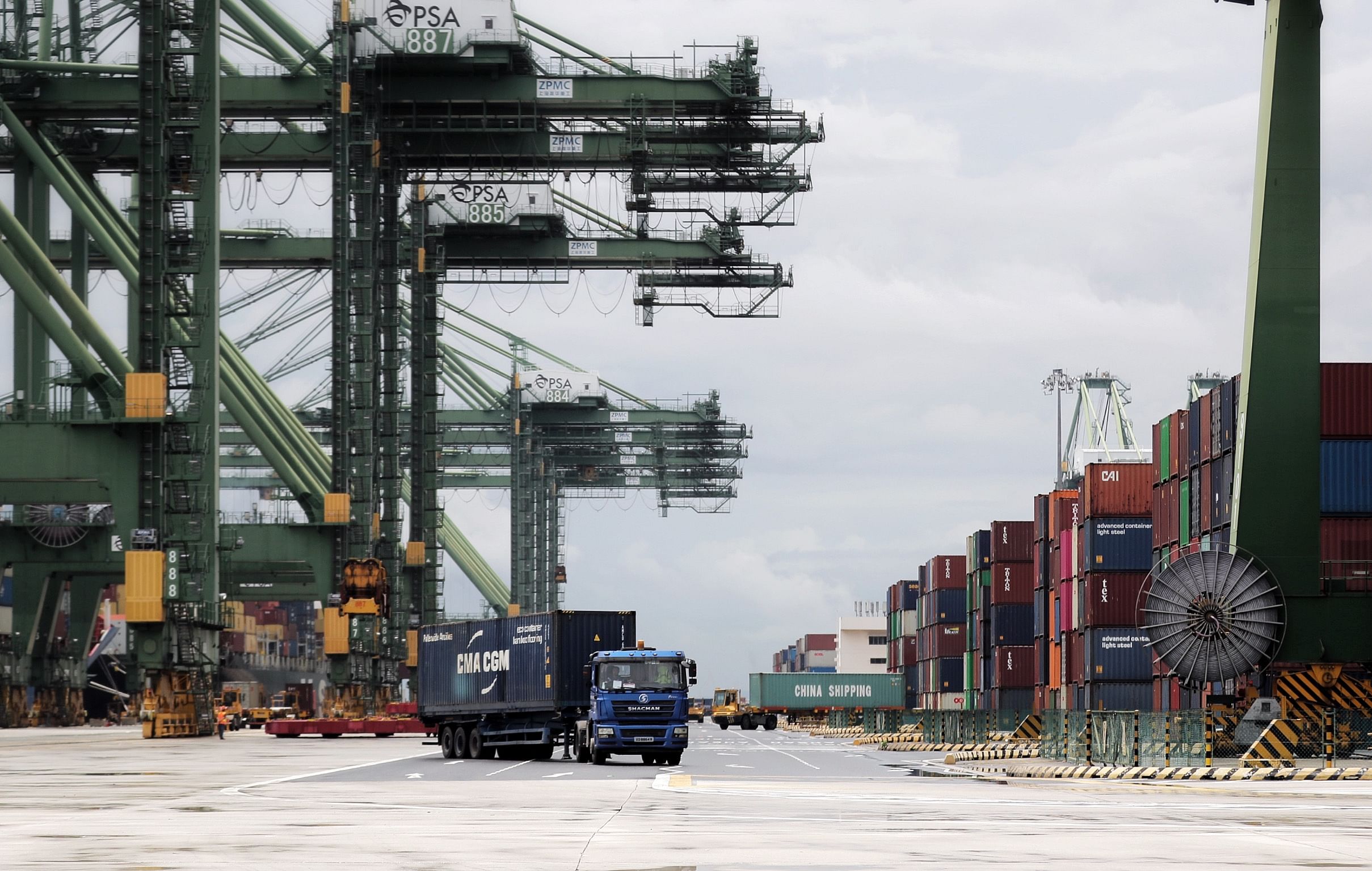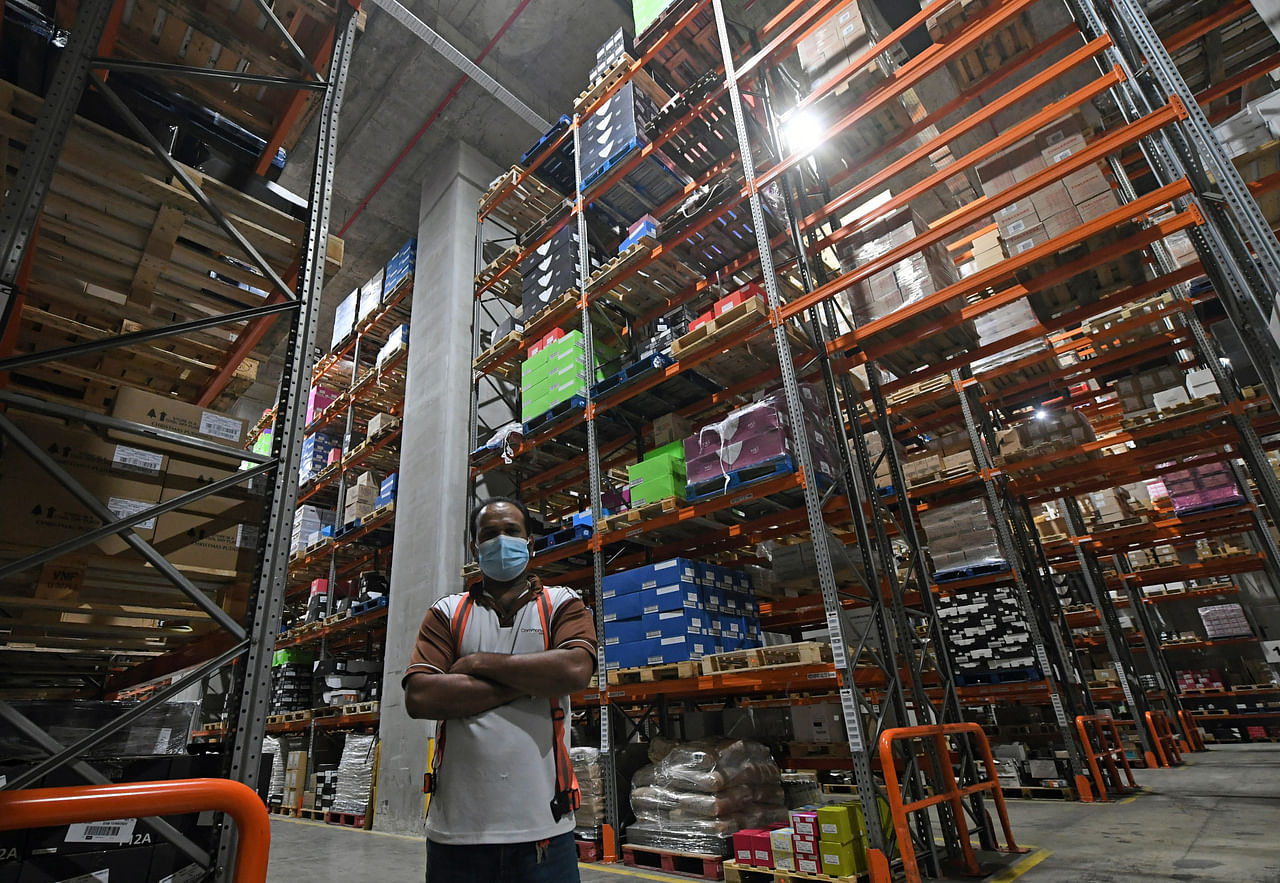
Supply chains, interrupted: Retailers in S'pore race to replenish festive stocks
SINGAPORE – With just three weeks to go until Christmas, retailers are racing to replenish their stocks of festive items and fighting the supply chain crunch to do so.
While many are still sweating over whether their merchandise will arrive in time to catch holiday shoppers, some have learnt from last year’s Covid-19 pandemic disruptions and started stocking their inventories early.
For the past 1½ months, Mr Daniel Chua of Ji Mei Flower has been anxiously tracking his shipments of live Christmas trees from the United States.
About 500 trees arrived in mid-November after a week’s delay and 1,000 more trees are scheduled to arrive tomorrow.
The 35-year-old business development manager said he started planning for the shipments in August and paid 50 per cent more in shipping fees this year.
Despite selecting the shipping route with the least number of port calls, the shipments from the US still faced congestion and delay in every port that the vessel has transited, said Mr Chua.
When The Straits Times visited Ji Mei Flower two weeks ago, some varieties of the trees from the US had sold out within a few days of the first shipment arriving.

Prices start at $85 for a 0.9m- to 1.2m-tall tree and go up to over $1,000 for a 3.3m- to 3.6m-tall tree. They have risen by about 20 per cent from last year’s prices across the various nurseries, said Mr Chua.
All around the world, a boom in demand for goods has been adding to supply chain bottlenecks.
Mr Rakesh Agarwal, partner, advisory, at KPMG, said multiple factors have contributed to increased consumption, such as pandemic fiscal assistance from governments that fuelled spending power, and working from home, which boosted demand for goods that improved the quality of home life.
“Thus, during the pandemic, demand quickly rebounded but supply was severely constrained, which further complicated the matter for supply chain organisations,” said Mr Agarwal, who is also the head of supply chain practice for the Asia-Pacific region.
An annual report by Facebook and Bain released in August showed that South-east Asia, led by Indonesia, has added 70 million new online shoppers since the start of the pandemic.
A PSA Singapore spokesman told The Straits Times that in the first 10 months of this year, the port operator handled 30.87 million twenty-foot equivalent units (TEUs), a 2.2 per cent increase over the same period last year. Throughput handled in 2020 was 36.6 million TEUs.
The disruption to supply chains, which reverberated around the world, started early last year when China, the centre of global manufacturing, first went into lockdown mode and shut its factories to contain the spread of the coronavirus.
Soon, factories in other economies, such as Malaysia, Vietnam and Taiwan, were forced to shut for the same reason.
Shipping firms reacted by cutting capacity and cancelling shipping routes. Some vessels were diverted to deliver protective gear all around the world.
When factories reopened, thousands of containers were stuck in different ports, and exporters in China did not have enough containers to ship their goods.
For more than a year, the world’s supply chains have seen unprecedented upheavals. Covid-19 lockdowns, production issues, shipping container shortages and labour disruptions have resulted in gridlocked ports around the world, sending freight fees skyrocketing.
Adding to the strain was a giant container ship grounded in the Suez Canal for almost a week in March, leaving more than 350 ships stuck in a floating traffic jam.
In its latest attempt to keep the coronavirus out, China has imposed up to a seven-week quarantine for returning Chinese seafarers.
“These tight Covid-related measures do mean that China, as the factory of the world, may still contribute to exporting inflation to the rest of the world as port congestion and Covid-19 disruptions upend the best laid plans for Christmas sales,” said OCBC Bank’s chief economist Selena Ling.
Consumers like Ms Sherry Lim are hoping that their purchases will be delivered before Christmas.
The 45-year-old manager, who bought some accessories from e-commerce platform Taobao this week, said: “If the accessories don’t arrive by next week, I will have to redo my gifting list and buy locally.”
Mr Marc Laurence, general manager of Seafrigo, a food logistics specialist, had anticipated that the rush to stock up for Christmas could further swamp the system, and advised his clients to start shipping foodstuffs as early as June.
His recent shipment of frozen lobsters took 75 days to be moved from Boston to Singapore, when it would have taken 35 days before the pandemic.
Shipping costs to Singapore from the US have trebled and it costs six times more to ship from Perth, said Mr Laurence.
Shipping agents are fighting every day to find space for their shipments, he said. Vessels are overbooked and cargo gets bumped off ships to make space for the goods of firms that can pay more.

Ms Pearline Goh, director of Swift Health Food, decided to increase her imports of Christmas products by 40 per cent this year, after the overwhelming response from shoppers who wiped out her shelves of Christmas products by mid-December last year.
Besides bringing in her usual Christmas fare of hot chocolate, tea, biscuits and wine from Whittard in the United Kingdom and Maxim in France, this year, Ms Goh also shipped a 20-foot container of premium panettone, a traditional cake, from Loison in Italy.
She said she placed her orders in June for the shipments to depart in August, in order to hit department store shelves by October.
“Most of the retailers want to start early to entice footfall so we had to gear up for earlier preparation for this festive season,” she said.
With shipping fees up by 30 per cent to 40 per cent, Ms Goh said retail prices will also increase by about 5 per cent to 10 per cent from those of last year.
Besides food and Christmas merchandise, containers coming into Singapore are also filled with building materials ordered for home owners rushing to finish renovations by Christmas.
Mr Andy Lim, director of GF+A Global, which imports premium tiles and sanitary ware from Europe, said: “Shipments have been erratic. Even if we pay more for shipping, there is no guarantee that our products will make it onto the vessel.”
Mr Lim said he paid two to three times more for his products to be air-flown from Italy, after recent bad weather worsened the congestion at various ports.
But he is not passing this on to his customers, he said, as the market is very competitive. After almost a year of poor business, he is hoping sales volume this year will cover his increase in shipping costs.
Some industry experts said global supply chain bottlenecks will start to ease after the holiday shopping ends.
However, Ms Ling felt that “the signals are still very mixed”.
“While there are some anecdotal reports that the worst of the global supply chain bottlenecks are easing, the news arena is still replete with reports ranging from Christmas tree shortages ahead of the Christmas holiday season to fried chicken being removed from Japan’s 7-Eleven menu,” she said.
“Given the recent emergence of the Omicron (virus) variant and the lightning quick responses by some countries to tighten their border controls, it remains to be seen if there could be potential impact on consumer demand and if these could exacerbate supply chain bottlenecks and worsen inflation concerns.”
Supply chains, interrupted: Logistics workers ensure timely delivery of goods
For 12 hours a day, Mr Kumaran Panjanathan inspects products from shipments on arrival, checks inventory levels in the warehouse, and picks and packs supplies for deliveries to clients.
The 47-year-old warehouse supervisor is responsible for overseeing the inventory and food supplies of Seafrigo’s customers, to ensure that they do not run out of stocks amid the global supply chain disruptions.
“We do stock counts every day and we will inform our customers when their inventory levels are low or if the expiry dates of their food are near,” said Mr Kumaran.
The two-month circuit breaker last year and the various dining restrictions that followed have greatly impacted the flow of food supplies for some customers.
Some food and beverage operators had to fly in supplies when items ran out quickly after dining curbs were lifted, as ships would take too long to arrive, he noted.
Others had to order greater quantities since shipping schedules have become unpredictable because of port congestion caused by, among other factors, Covid-19 outbreaks.

Since the start of the peak year-end season in October, Mr Kumaran’s work has been more exhausting than ever. He works from 7.30am to 7.30pm from Mondays to Fridays, and half a day on Saturdays.
There are shipments arriving every day and deliveries to arrange for clients, he said.
Among the clients of Seafrigo, a food logistics specialist, are Marks & Spencer, French bakery Paul and Cold Storage.
“Festive products for Marks & Spencer run out very fast. Every day, I will have deliveries from the warehouse to the stores. And I need to keep track and alert the client when supply is low,” said Mr Kumaran.
Front-line workers like him play an important role in ensuring that supply chains for their clients are not broken.
Logistics providers, too, are rising to the occasion by working round the clock.
Mr Terence Tan, managing director of UEI Logistics, has staggered working hours for his staff so that they can keep track of shipments.
“If they are not working, the transport providers will continue to monitor the shipments for us. We have a very efficient port system. Sometimes, (port operator) PSA will discharge containers at odd hours,” said Mr Tan, 57.
Since the fourth quarter of last year, PSA Singapore has rolled out measures including offering real-time visibility of cargo and their status and priority discharge of containers, to help cushion the blow of the global chain upheavals for cargo owners and shipping lines.
The efficiency of Singapore, the world’s largest transhipment hub, has also allowed shipping lines to make up for lost time and connections.
Join ST’s Telegram channel here and get the latest breaking news delivered to you.
Source: Read Full Article
